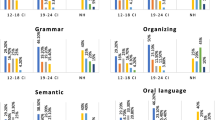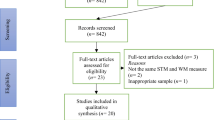Abstract
Purpose
Executive functions (EF) play a fundamental role in planning and executing goal-driven behaviours. The purpose of this systematic review and meta-analysis was to investigate EF skills mastered by preschool/school-age cochlear implanted children (CIC) without morpho-functional abnormalities and to compare their outcomes with typically hearing children (THC).
Methods
Bibliographic search for observational studies of any language/date up to 16 December 2022 was performed with the following electronic databases: PubMed, Scopus, and Web of Science. After removal of duplicates, 2442 records were subjected to a three-stage screening process and 83 potentially eligible articles were identified. A total of 15 studies was included in the final analysis: 9 articles directly meeting the eligibility criteria plus 6 more studies thanks to the authors sharing their data set, specifically for participants who met present inclusion criteria.
Results
Meta-analysis showed a statistically significant difference only for verbal short-term memory, whereas group differences for visuospatial short-term memory and verbal/visuospatial working memory were not significant. For fluency skills, meta-analysis revealed statistical significance for the semantic fluency task but not for the rapid naming test. Qualitative analysis reflected group similarities in flexibility but CIC’s difficulties in auditory attention/planning skills. Controversial findings for inhibitory control skills were observed.
Conclusions
EF performance comparisons between CIC and THC show inter-skill and inter-test variances. Due to the paucity of existing studies, present findings should be interpreted with caution. Future research in this domain is strongly recommended.




Similar content being viewed by others
Data availability statement
The data sets generated during and/or analyzed during the current study are available from the corresponding author on reasonable request.
References
Barkley RA (2012) Executive functions: what they are, how they work, and why they evolved. The Guilford Press, New York
Kral A, Kronenberger WG, Pisoni DB, O’Donoghue GM (2016) Neurocognitive factors in sensory restoration of early deafness: a connectome model. Lancet Neurol 5(6):610–621. https://doi.org/10.1016/S1474-4422(16)00034-X
Cupples L, Ching TY, Button L et al (2018) Spoken language and everyday functioning in 5-year-old children using hearing aids or cochlear implants. Int J Audiol 57(sup2):S55–S69. https://doi.org/10.1080/14992027.2017.1370140
Kronenberger WG, Beer J, Castellanos I et al (2014) Neurocognitive risk in children with cochlear implants. JAMA Otolaryngol Head Neck Surg 140(7):608–615. https://doi.org/10.1001/jamaoto.2014.757
Charry-Sanchez JD, Ramírez-Guerrero S, Vargas-Cuellar MP et al (2022) Executive functions in children and adolescents with hearing loss: a systematic review of case-control, case series, and cross-sectional studies. Salud Ment 45(1):35–49. https://doi.org/10.17711/sm.0185-3325.2022.006
Akçakaya H, Jayakody D, Doğan M (2023) Systematic review and meta-analysis of STM and WM in long-term CI users. Contemp Sch Psychol 27:61–80. https://doi.org/10.1007/s40688-022-00408-6
Diamond A, Lee K (2011) Interventions shown to aid executive function development in children 4 to 12 years old. Science 333(6045):959–964. https://doi.org/10.1126/science.1204529
Wells G, Shea B, O’Connell D, Peterson J, Welch V, Losos M, Tugwell P (2013) The Newcastle-Ottawa Scale (NOS) for assessing the quality of nonrandomised studies in meta-analyses. http://www.ohri.ca/programs/clinical_epidemiology/oxford.asp
Higgins JPT, Thompson SG, Deeks JJ, Altman DG (2003) Measuring inconsistency in meta-analyses BMJ Open 327:557–560. https://doi.org/10.1136/bmj.327.7414.557
Higgins J, Thomas J, Chandler J, Cumpston M, Li T, Page M et al (2021) Cochrane handbook for systematic reviews of interventions version 6.2 (February 2021). Cochrane. https://www.training.cochrane.org
Huber M, Kipman U (2012) Cognitive skills and academic achievement of deaf children with cochlear implants. Otolaryngol Head Neck Surg 147(4):763–772. https://doi.org/10.1177/0194599812448352
Lee Y, Yim D, Sim H (2012) Phonological processing skills and its relevance to receptive vocabulary development in children with early cochlear implantation. Int J Pediatr Otorhinolaryngol 76(12):1755–1760. https://doi.org/10.1016/j.ijporl.2012.08.016
López-Higes R, Gallego C, Martín-Aragoneses MT, Melle N (2015) Morpho-syntactic reading comprehension in children with early and late cochlear implants. J Deaf Stud Deaf Educ 20(2):136–146. https://doi.org/10.1093/deafed/env004
Talli I, Tsalighopoulos M, Okalidou A (2018) The relation between short-term memory and vocabulary skills in Greek children with cochlear implants: the role of hearing experience. First Lang 38(4):359–381. https://doi.org/10.1177/0142723717749073
Sanei N, Mohammadkhani G, Motasaddi Zarandy M, Jalaie S (2018) Comparison of sustained auditory attention between children with cochlear implant and normal children. Aud Vestib Res 27(1):38–44
Akçakaya H, Doğan M, Gürkan S, Koçak Ö, Yücel E (2019) Early cochlear implantation: verbal working memory, vocabulary, speech intelligibility and participant variables. Cochlear Implants Int 20(2):62–73. https://doi.org/10.1080/14670100.2019.1565077
Chen Y, Yue Z, Liang M, Liu J, Li S, Liu J, Zheng Y (2019) Auditory selective attention hindered by visual stimulus in prelingually deaf children with cochlear implants. Otol Neurotol 40(5):e542–e547. https://doi.org/10.1097/MAO.0000000000002169
Jing L, Vermeire K, Mangino A, Reuterskiöld C (2019) Rhyme awareness in children with normal hearing and children with cochlear implants: an exploratory study. Front Psychol 10:2072. https://doi.org/10.3389/fpsyg.2019.02072
Volpato F (2020) Verbal working memory resources and comprehension of relative clauses in children with cochlear implants. First Lang 40(4):390–410. https://doi.org/10.1177/0142723719900739
Gremp M (2011) The effects of visuospatial sequence training with children who are deaf or hard of hearing. All Theses Diss (ETDs). https://doi.org/10.7936/K7D50JZV
Botting N, Jones A, Marshall C, Denmark T, Atkinson J, Morgan G (2017) Nonverbal executive function is mediated by language: a study of deaf and hearing children. Child Dev 88(5):1689–1700. https://doi.org/10.1111/cdev.12659
Marshall CR, Jones A, Fastelli A, Atkinson J, Botting N, Morgan G (2018) Semantic fluency in deaf children who use spoken and signed language in comparison with hearing peers. Int J Lang Commun Disord 53(1):157–170. https://doi.org/10.1111/1460-6984.12333
Figueroa M, Silvestre N, Darbra S (2022) Specific EF-related tasks and reading in adolescents with typical hearing or a cochlear implant. Commun Disord Q 43(3):152–162. https://doi.org/10.1177/1525740120976109
De Giacomo A, Murri A, Matera E, Pompamea F, Craig F, Giagnotti F, Bartoli R, Quaranta N (2021) Executive functions and deafness: results in a group of cochlear implanted children. Audiol Res 11(4):706–717. https://doi.org/10.3390/audiolres11040063
Jamsek IA, Holt RF, Kronenberger WG, Pisoni DB (2021) differential at-risk pediatric outcomes of parental sensitivity based on hearing status. J Speech Lang Hear Res 64(9):3668–3684. https://doi.org/10.1044/2021_JSLHR-20-00491
Faraone SV (2008) Interpreting estimates of treatment effects: implications for managed care. PT 33(12):700–711
Scerrati E, Lugli L, Nicoletti R et al (2017) Comparing stroop-like and Simon effects on perceptual features. Sci Rep 7:17815. https://doi.org/10.1038/s41598-017-18185-1
Misurelli SM, Goupell MJ, Burg EA, Jocewicz R, Kan A, Litovsky RY (2020) Auditory attention and spatial unmasking in children with cochlear implants. Trends Hear 24:2331216520946983. https://doi.org/10.1177/2331216520946983
Dye MW, Bavelier D (2010) Attentional enhancements and deficits in deaf populations: an integrative review. Restor Neurol Neurosci 28(2):181–192. https://doi.org/10.3233/RNN-2010-0501
de Diego-Balaguer R, Martinez-Alvarez A, Pons F (2016) Temporal attention as a scaffold for language development. Front Psychol 7:44. https://doi.org/10.3389/fpsyg.2016.00044
Giallini I, Inguscio BMS, Nicastri M, Portanova G, Ciofalo A, Pace A, Greco A, D’Alessandro HD, Mancini P (2023) Neuropsychological functions and audiological findings in elderly cochlear implant users: the role of attention in postoperative performance. Audiol Res 13(2):236–253. https://doi.org/10.3390/audiolres13020022
Nicastri M, Giallini I, Inguscio BMS, Turchetta R, Guerzoni L, Cuda D, Portanova G, Ruoppolo G, Dincer D’Alessandro H, Mancini P (2023) The influence of auditory selective attention on linguistic outcomes in deaf and hard of hearing children with cochlear implants. Eur Arch Otorhinolaryngol 280(1):115–124. https://doi.org/10.1007/s00405-022-07463-y
Karltorp E, Eklöf M, Östlund E, Asp F, Tideholm B, Löfkvist U (2020) Cochlear implants before 9 months of age led to more natural spoken language development without increased surgical risks. Acta Paediatr 109(2):332–341. https://doi.org/10.1111/apa.14954
Ching TY, Zhang VW, Flynn C, Burns L, Button L, Hou S, Van Buynder P (2018) Factors influencing speech perception in noise for 5-year-old children using hearing aids or cochlear implants. Int J Audiol 57(sup2):S70–S80. https://doi.org/10.1080/14992027.2017.1346307
Nakata T, Trehub SE, Kanda Y (2012) Effect of cochlear implants on children’s perception and production of speech prosody. JASA 131(2):1307–1314. https://doi.org/10.1121/1.3672697
AuBuchon AM, Pisoni DB, Kronenberger WG (2019) Evaluating pediatric cochlear implant users’ encoding, storage, and retrieval strategies in verbal working memory. J Speech Lang Hear Res 62(4):1016–1032. https://doi.org/10.1044/2018_JSLHR-H-18-0201
Pickering SJ (2001) The development of visuo-spatial working memory. Memory 9(4–6):423–432. https://doi.org/10.1080/09658210143000182
Nittrouer S, Caldwell-Tarr A, Low KE, Lowenstein JH (2017) Verbal working memory in children with cochlear implants. J Speech Lang Hear Res 60(11):3342–3364. https://doi.org/10.1044/2017_JSLHR-H-16-0474
Baddeley AD (2001) Is working memory still working? Am Psychol 56(11):851–864. https://doi.org/10.1037/0003-066X.56.11.851
Hale JB, Hoeppner JAB, Fiorello CA (2002) Analyzing digit span components for assessment of attention processes. J Psychoeduc Assess 20(2):128–143. https://doi.org/10.1177/073428290202000202
Alloway TP, Gathercole SE, Willis C, Adams AM (2004) A structural analysis of working memory and related cognitive skills in young children. J Exp Child Psychol 87(2):85–106. https://doi.org/10.1016/j.jecp.2003.10.002
Kenett YN, Wechsler-Kashi D, Kenett DY, Schwartz RG, Ben-Jacob E, Faust M (2013) Semantic organization in children with cochlear implants: computational analysis of verbal fluency. Front Psychol 4:543. https://doi.org/10.3389/fpsyg.2013.00543
Hasher L, Lustig C, Zacks R (2007) Inhibitory mechanisms and the control of attention. In: Conway ARA, Jarrold C, Kane MJ, Miyake A, Towse JN (eds) Variation in working memory. Oxford University Press, Oxford, pp 227–249
Premack D, Woodruff G (1978) Does the chimpanzee have a theory of mind? Behav Brain Sci 1:515–526. https://doi.org/10.1017/S0140525X00076512
Choi YM, Jeong SW (2023) Theory of mind in children with cochlear implants: comparison with age- and sex-matched children with normal hearing. Am J Otolaryngol 44(2):103693. https://doi.org/10.1016/j.amjoto.2022.103693
Bunge SA, Zelazo PD (2006) A brain-based account of the development of rule use in childhood. Curr Dir Psychol Sci 15(3):118–121. https://doi.org/10.1111/j.0963-7214.2006.00419.x
Buss AT, Nikam B (2020) Not all labels develop equally: the role of labels in guiding attention to dimensions. Cogn Dev 53:100843. https://doi.org/10.1016/j.cogdev.2019.100843
Pea RD (1982) What is planning development the development of? New Dir Child Adolesc Dev 18:5–27
Senn TE, Espy KA, Kaufmann PM (2004) Using path analysis to understand executive function organization in preschool children. Dev Neuropsychol 26(1):445–464. https://doi.org/10.1207/s15326942dn2601_5
Larson C, Gangopadhyay I, Kaushanskaya M, Weismer SE (2019) The relationship between language and planning in children with language impairment. J Speech Lang Hear Res 62(8):2772–2784. https://doi.org/10.1044/2019_JSLHR-L-18-0367
Author information
Authors and Affiliations
Corresponding author
Ethics declarations
Conflict of interest
The authors declare that they have no conflicts of interest. This research was not financially supported.
Additional information
Publisher's Note
Springer Nature remains neutral with regard to jurisdictional claims in published maps and institutional affiliations.
Supplementary Information
Below is the link to the electronic supplementary material.
Rights and permissions
Springer Nature or its licensor (e.g. a society or other partner) holds exclusive rights to this article under a publishing agreement with the author(s) or other rightsholder(s); author self-archiving of the accepted manuscript version of this article is solely governed by the terms of such publishing agreement and applicable law.
About this article
Cite this article
Nicastri, M., Dincer D’Alessandro, H., Baccolini, V. et al. Executive functions in preschool and school-age cochlear implant users: do they differ from their hearing peers? A systematic review and meta-analysis. Eur Arch Otorhinolaryngol 281, 579–600 (2024). https://doi.org/10.1007/s00405-023-08260-x
Received:
Accepted:
Published:
Issue Date:
DOI: https://doi.org/10.1007/s00405-023-08260-x




